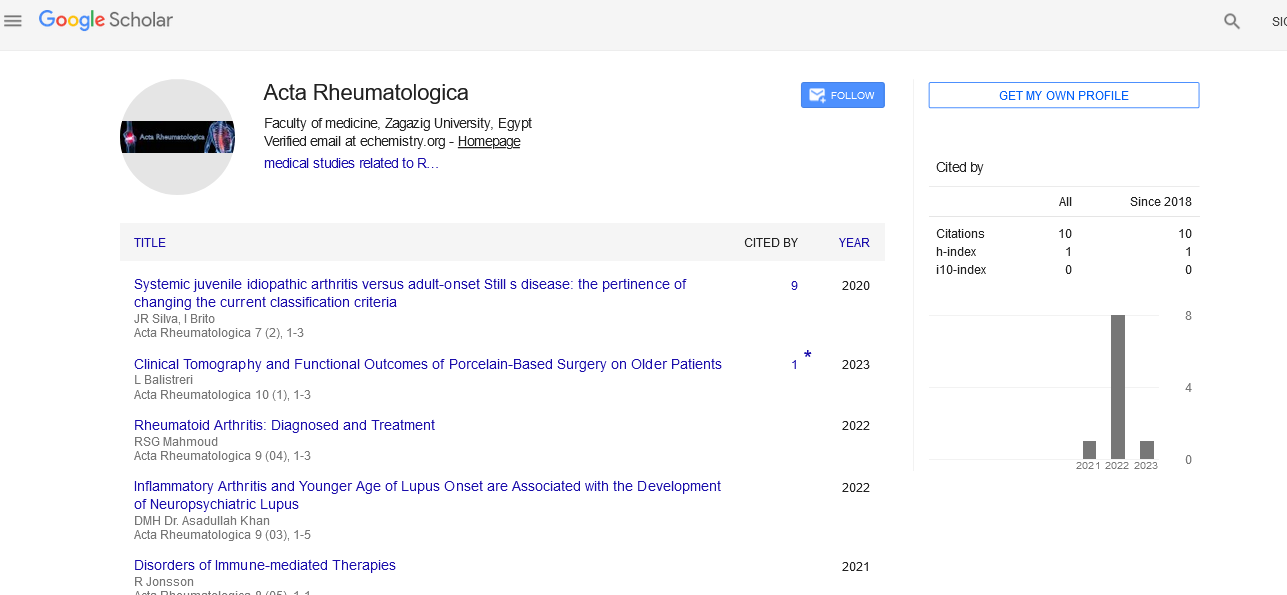Perspective - (2023) Volume 10, Issue 5
Psoriatic Arthritis: Understanding, Managing, and Living with a Complex Condition
Kassem Sharif*
Department of Medical and Healthcare, Bar-Ilan University, Israel
*Correspondence:
Kassem Sharif, Department of Medical and Healthcare, Bar-Ilan University,
Israel,
Email:
Received: 05-Sep-2023, Manuscript No. ipar-23-14251;
Editor assigned: 08-Sep-2023, Pre QC No. ipar-23-14251 (PQ);
Reviewed: 25-Sep-2023, QC No. ipar-23-14251;
Revised: 03-Oct-2023, Manuscript No. ipar-23-14251 (R);
Published:
11-Oct-2023
Introduction
Psoriatic Arthritis (PsA) is a chronic autoimmune condition that affects individuals living with psoriasis. It is a multifaceted disease, intertwining both joint inflammation and skin manifestations, posing significant challenges in diagnosis and management. This article aims to delve into the intricacies of Psoriatic Arthritis, from its clinical characteristics to its impact on individuals and the evolving approaches in its treatment.
Understanding psoriatic arthritis
Psoriatic arthritis is a unique autoimmune condition marked by joint pain, stiffness, and swelling that often accompanies the skin disorder psoriasis. While not everyone with psoriasis develops psoriatic arthritis, those affected can experience joint inflammation and stiffness that can vary from mild to severe, affecting any joint in the body. This condition typically manifests between the ages of 30 and 50 but can occur at any age.
Clinical presentation and challenges in diagnosis
The presentation of psoriatic arthritis is diverse and can include various patterns, such as asymmetric arthritis affecting joints on one side of the body, spondylitis affecting the spine, or dactylitis, known as "sausage fingers" due to inflammation. The overlap of symptoms with other types of arthritis, such as rheumatoid arthritis, poses challenges in diagnosing PsA accurately.
Description
Impact on quality of life
Psoriatic arthritis is not just a physical ailment; it significantly impacts the quality of life for those affected. Chronic pain, stiffness, fatigue, and the visible skin manifestations can lead to emotional distress, reduced mobility, limitations in daily activities, and decreased productivity. Moreover, the unpredictability of flares can be emotionally taxing, affecting relationships and mental well-being.
Treatment approaches and evolving therapies
The management of psoriatic arthritis involves a multidisciplinary approach, combining medication, physical therapy, lifestyle modifications, and sometimes surgery. Nonsteroidal Anti-Inflammatory Drugs (NSAIDs), Disease-Modifying Antirheumatic Drugs (DMARDs), and biologic therapies are commonly used to reduce inflammation and manage symptoms. Recent advancements in targeted therapies and biologics have provided more effective and specific treatment options, offering hope for improved outcomes and reduced disease progression.
Lifestyle modifications and self-care
Beyond medications, lifestyle adjustments play a crucial role in managing psoriatic arthritis. Regular exercise, maintaining a healthy weight, adopting joint protection techniques, and stress management are essential. Additionally, a balanced diet with anti-inflammatory properties may help reduce symptoms and improve overall health.
Psychological support and patient education
Patients with psoriatic arthritis benefit from psychological support and education. Support groups, counseling, and patient education programs help individuals understand their condition, manage expectations, and learn coping mechanisms to deal with the challenges posed by PsA.
Research and future outlook
Ongoing research in psoriatic arthritis focuses on understanding the underlying causes, identifying biomarkers for early diagnosis, and developing more targeted and personalized treatments. The future holds promise for more precise and effective therapies that may alter the course of the disease and improve the quality of life for those affected by psoriatic arthritis.
Signs and symptoms
Agony, enlarging, or solidness in at least one joints is regularly present in psoriatic arthritis. Psoriatic joint inflammation is provocative, and impacted joints are by and large red or warm to the touch. Hilter kilter oligoarthritis, characterized as irritation influencing two to four joints during the initial a half year of illness, is available in 70% of cases. Be that as it may, in 15% of cases, the joint pain is balanced. The joints of the hand that is engaged with psoriasis are the proximal interphalangeal, the distal interphalangeal, the metacarpophalangeal joint, and the wrist. Contribution of the distal interphalangeal joints is a trademark highlight present as a rule. Nail pitting frequently goes with distal interphalangeal joint contribution and might be fundamental in separating psoriatic joint inflammation from other diseases. As well as influencing the joints of the hands and wrists, psoriatic joint inflammation might influence the fingers, nails, and skin. Wiener like enlarging in the fingers or toes, known as dactylitis, may occur. Psoriasis can likewise make changes the nails, for example, pitting or division from the nail bed, onycholysis, hyperkeratosis under the nails, and level ridging. Psoriasis traditionally gives layered skin sores, which are most usually seen over extensor surfaces like the scalp, natal separated and umbilicus. In psoriatic joint inflammation, torment can happen in the space of the sacrum (the lower back, over the tailbone), because of sacroiliitis or spondylitis, which is available in 40% of cases.
Torment can happen in and around the feet and lower legs, particularly enthesitis in the Achilles ligament (irritation of the Achilles ligament where it embeds into the bone) or plantar fasciitis in the underside of the foot. Alongside the above-noted torment and aggravation, there is outrageous weariness that doesn't disappear with satisfactory rest. The depletion might keep going for days or weeks without reduction. Psoriatic joint pain might stay gentle or may advance to more disastrous joint illness. Times of dynamic sickness, or flares, will regularly substitute with times of reduction. In extreme structures, psoriatic joint pain might advance to joint inflammation mutilans which on X-beam gives a "pencil-in-cup" appearance. Since delayed aggravation can prompt joint harm, early conclusion and treatment to slow or forestall joint harm is suggested.
Conclusion
Psoriatic arthritis presents a complex interplay between
joint inflammation and skin manifestations, significantly
impacting the lives of those affected. Through a
multidisciplinary approach, including evolving treatment
modalities, lifestyle adjustments, and psychological support,
individuals can better manage the symptoms and improve
their quality of life. Ongoing research and advancements in
therapeutic options offer hope for a brighter future,
emphasizing the importance of comprehensive care and
support for those navigating life with psoriatic arthritis.





